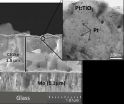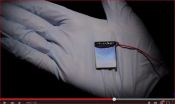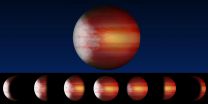(Press-News.org) Many of us are familiar with electrolytic splitting of water from their school days: if you hold two electrodes into an aqueous electrolyte and apply a sufficient voltage, gas bubbles of hydrogen and oxygen are formed. If this voltage is generated by sunlight in a solar cell, then you could store solar energy by generating hydrogen gas.This is because hydrogen is a versatile medium of storing and using "chemical energy". Research teams all over the world are therefore working hard to develop compact, robust, and cost-effective systems that can accomplish this challenge. But it is not that simple, because an efficient hydrogen generation preferably proceeds in an acidic electrolyte corroding very fast solar cells. Electrodes that so far have been used are made of very expensive elements such as platinum or platinum-iridium alloys.
New photocathode with several advantages
Under the "Light2Hydrogen" BMBF Cluster project and an on-going "Solar H2" DFG Priority programme, a team from the HZB Institute for Solar Fuels has now developed a novel photoelectrode that solves these problems: it consists of chalcopyrite (a material used in device grade thin film solar cells) that has been coated with a thin, transparent, conductive oxide film of titanium dioxide (TiO2). The special characteristics are: the TiO2 film is polycrystalline and contains a small amount of platinum in the form of nanoparticles. This new composite presents some special talents. Firstly, it produces under sun light illumination a photovoltage of almost 0.5 volts and very high photocurrent densities of up to 38 mA/cm2; secondly, it acts as a catalyst to accelerate the formation of hydrogen, and finally, it is chemically protected against corrosion as well. Since TiO2 is transparent, almost all sun light reaches the photoactive chalcopyrite, leading to the observed high photocurrent density and photovoltage comparable with those of a conventional device-grade thin-film solar cell.
HZB recipe and technology
The recipe for this novel and elegant coating was developed by Anahita Azarpira in the course of her doctoral studies in a team headed by Assoc. Prof. Thomas Schedel-Niedrig. She uses a chemical vapour coating technique (sprayed ion-layer gas reaction/Spray-ILGAR) that was developed and patented at the HZB Institute for Heterogeneous Material Systems (EE-IH). In this process, the titanium dioxide and platinum precursors are dissolved in ethanol and converted to a fog using an ultrasonic bath. The produced aerosol is directed over the heated substrate using a stream of nitrogen gas resulting into a polycrystalline thin film grown on the chalcopyrite substrate over time with embedded nanoparticles of platinum.
More than 80 % of light converted
Azarpira and her colleagues varied the amount of platinum in the precursor solution in order to optimize the properties of the novel composite photoelectrode device.The properties were optimal with a volumetric proportion of about 5 % platinum (H2PtCl6) in the precursor solution." More than 80 % of the incident visible sunlight was photoelectrically converted by this composite system into electric current available for the hydrogen generation", says Schedel-Niedrig. That means little light is lost and the quantum efficiency is virtually very high. In addition, it has been reported in the very recently published article that the composite shows high long-term stability over 25 hours and reveals large photoelectrocatalytic activity of about 690 hydrogen molecules produced per second and per active center at the surface under illumination.
Feasibility demonstrated
However, there is still a lot to do. Currently, the majority of the required voltage between the composite photocathode and a platinum counter electrode of around 1.8 volts is still coming from a battery. Hence the solar-to-hydrogen efficiency has to be clearly improved. "But anyway, we demonstrate the feasibility of such future-oriented chemical robust photoelectrocatalytic systems that have the potential to convert solar energy to hydrogen, i.e to chemical energy for storage. As a consequence we have successfully developed and tested a demonstrator device for solar hydrogen production with a company in Schwerin under the Light2Hydrogen project, according to Schedel-Niedrig.
INFORMATION:
Publikation: Azarpira, A., Lublow, M., Steigert, A., Bogdanoff, P., Greiner, D., Kaufmann, C. A., Krueger, M., Gernert, U., van de Krol, R., Fischer, A. and Schedel-Niedrig, T. (2015), Efficient and Stable TiO2:Pt-Cu(In,Ga)Se2 Composite Photoelectrodes for Visible Light Driven Hydrogen Evolution. Adv. Energy Mater.. doi: 10.1002/aenm.201402148
PS: We demonstrate the production of the composit photocathode in a short filmclip in our HZBkanal.
https://www.youtube.com/watch?v=gzrDtZkCwqc
For the first time, a researcher at the University of Waterloo has theoretically demonstrated that it is possible to detect a single nuclear spin at room temperature, which could pave the way for new approaches to medical diagnostics.
Published in the journal Nature nanotechnology this week, Amir Yacoby from the University of Waterloo, along with colleagues from University of Basel and RWTH Aachen University, propose a theoretical scheme that could lead to enhanced Nuclear Magnetic Resonance (NMR) imaging of biological materials in the near future by using weak magnetic ...
TORONTO, ON -- "Cloudy for the morning, turning to clear with scorching heat in the afternoon."
While this might describe a typical late-summer day in many places on Earth, it may also apply to planets outside our solar system, according to a new study by an international team of astrophysicists from the University of Toronto, York University and Queen's University Belfast.
Using sensitive observations from the Kepler space telescope, the researchers have uncovered evidence of daily weather cycles on six extra-solar planets seen to exhibit different phases. Such phase ...
In a new study published in the Protein & Cell, Chen-Yu Zhang's group at Nanjing University reports that small non-coding RNAs in maternal food can transfer through placenta to regulate fetal gene expression.
MicroRNAs (miRNA) are a class of noncoding RNAs with lengths of approximately 22 nucleotides that bind to target messenger RNAs to inhibit protein translation. In previous studies, the same group has found that plant miRNAs can enter into the host blood and tissues via the route of food-intake. The food-derived exogenous miRNAs are absorbed, packaged into microvesical ...
WASHINGTON, DC -- May 12, 2015-- A multidisciplinary group of US-based researchers has shown that the mixture of species found within natural bacterial communities in the environment can accurately predict the presence of contaminants such as uranium, nitrate, and oil. The findings, published this week in mBio, the online open-access journal of the American Society for Microbiology, show that the rapid sequencing of microbiomes in place at environmental sites can be used to monitor damage caused by human activity.
"This approach might be a general way for us to see anthropogenic ...
Nerve cells that produce dopamine for the purpose of transmitting signals to other cells affect numerous crucial brain functions. This becomes evident in diseases such as Parkinson's and schizophrenia, where dopamine transmission in the brain is impaired. In collaboration with researchers from Bonn, RUB scientists at the Mercator Research Group "Structure of Memory" have now identified in what way a specific form of this important cell is generated and which networks it forms in the course of brain development. In the process, the researchers discovered a data highway of ...
Amsterdam, May 12, 2015 - Wearable E-skin that can measure heart rate and blood pressure, and paper diagnostic machines the size of a credit card that can give instant readings on blood and saliva samples are two new bio-sensing technologies presented at Elsevier's 4th International Conference on Bio-Sensing Technology in Lisbon, Portugal on 12 May 2015.
Bio-sensors can detect and analyze data to give patients information on their heart rate and blood pressure, blood sugar and hormone levels, and even test whether they are infected with antibiotic-resistant bacteria. ...
SAN FRANCISCO, CA--MAY 11, 2015--Scientists have discovered a way to regrow bone tissue using the protein signals produced by stem cells. This technology could help treat victims who have experienced major trauma to a limb, like soldiers wounded in combat or casualties of a natural disaster. The new method improves on older therapies by providing a sustainable source for fresh tissue and reducing the risk of tumor formation that can arise with stem cell transplants.
The new study, published in Scientific Reports, is is the first to extract the necessary bone-producing ...
First there were canaries in coal mines, now there are microbes at nuclear waste sites, oil spills and other contaminated environments. A multi-institutional team of more than 30 scientists has found that statistical analysis of DNA from natural microbial communities can be used to accurately identify environmental contaminants and serve as quantitative geochemical biosensors. This study was sponsored by ENIGMA, a U.S. Department of Energy (DOE) Office of Science "Scientific Focus Area Program" based at the Lawrence Berkeley National Laboratory (Berkeley Lab).
"Changes ...
Researchers at Case Western Reserve University combined finely crafted nanoparticles with one of nature's potent disrupters to prevent the spread of triple-negative breast cancer in mouse models.
The highly aggressive cancer subtype is difficult to manage and, currently, the FDA has no approved targeted treatments. But striking results from a new study, published in the journal Cancer Research make the researchers optimistic they have a potential game-changer for triple negative cancer and more.
"There are multiple targets within a cell," said William Schiemann, professor ...
Pregnant women who exercise can significantly lower the risk of undergoing Caesarean sections and giving birth to large babies, a University of Alberta study has found.
Prenatal exercise has been suggested to be a means to prevent childhood obesity through a "normalization" in birth weight (ie. reducing the risk of having a large baby at birth). University of Alberta researchers conducted a meta-analysis to analyze 28 randomized control studies encompassing 5,322 women that looked at the influence of maternal exercise on baby outcomes.
"We found that women who exercised ...



